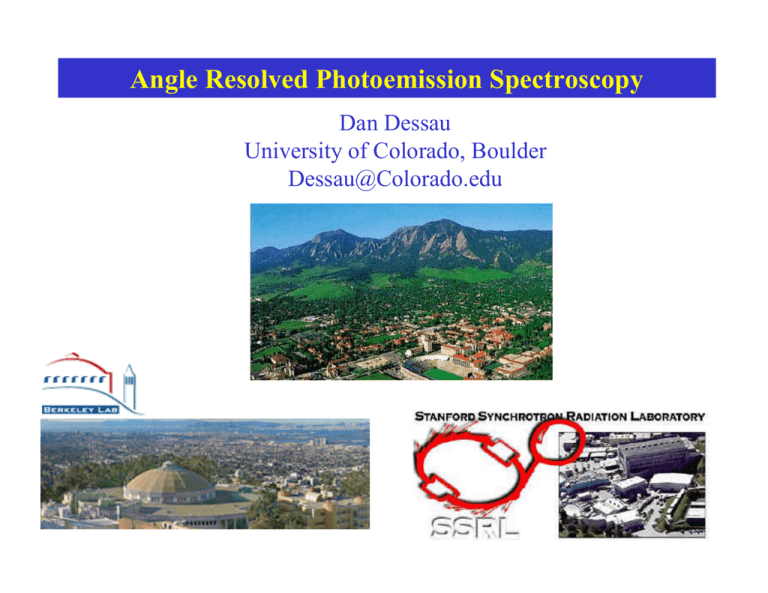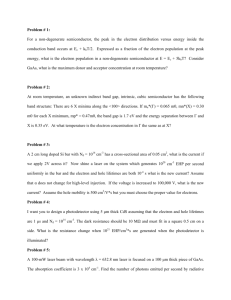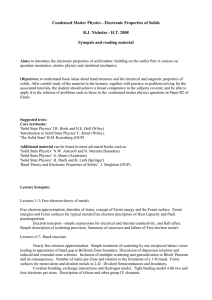Angle Resolved Photoemission Spectroscopy Dan Dessau University of Colorado, Boulder
advertisement

Angle Resolved Photoemission Spectroscopy Dan Dessau University of Colorado, Boulder Dessau@Colorado.edu sample hν Energy Photoemission Spectroscopy High K.E. Low B.E. e- hν analyzer EF e- Primary electrons – no scattering events. Contain information of density of states Secondary electrons (inelastic background) – increases with decreasing kinetic energy. Density of States Low K.E. High B.E. Three Step Model W.E. Spicer Angle resolved photoemission spectroscopy • Angle–dependent core level spectroscopy (not this talk) • To vary the surface sensitivity of an experiment •normal emission – more bulk sensitive •glancing emission – more surface sensitive • To perform X-ray photoelectron Diffraction (XPD) •Obtain local structural information (similar to EXAFS) •Angle-dependent valence band spectroscopy (this talk) • To measure the k (momentum) dependence of valence band states • To measure electronic band dispersions and Fermi Surfaces • To measure symmetries of states • To obtain many-body phenomena (e.g. correlated electron systems). Quantum numbers E,k KE Newton : KE=0.5 mv2 = p2/2m p=mv, p=hk -1.0 -0.5 0.0 0.5 1.0 p Energy (E) and momentum (p or k) are the most important quantum numbers in a solid. Specifying these specifies behavior of electrons. Pauli Principle - each electron goes into it’s own individual quantum state (new E,k). Fill lowest energy states first. Highest energy electrons are at Fermi Energy EF, with a momentum hkF. These are the most important electrons. All low energy excitations come from near EF. E Low energy excitation EF unoccupied ky occupied -1.0 -0.5 -kF 0.0 0.5 kF 1.0 k Fermi Surface Brillouin Zone kx Electrons in a periodic potential KE a -p/a p/a k Band Structure calculation of Bi2Sr2CaCu2O8 (Bi2212). Energy (eV) G=2p/a S. Massidda et al, Physica C 152, 251 (1988) Everything still mean-field or static - no correlation effects yet. Metals and Insulators Band theory: EF in a band --> Metal. EF in a gap between bands --> insulator E E 2s band Solid H (metal) EF -p/a p/a EF 1s band k -p/a p/a Solid He (insulator) k Mott Insulators - Failure of this model Insulator U=-ke2/r Costs Energy U Upper Hubbard Band E Metal EF U Lower Hubbard Band W DOS Effects most important in localized (d- and f-electron systems). ==> High Tc superconductors, Colossal Magnetoresistive oxides, etc. Angle Resolved Photoemission (ARPES) A momentum resolved spectroscopy Most direct way to measure E vs. k of a solid. Intensity ∝ ∑ hν i,f A φ detector θ e- sample Electron momentum Parallel to the surface is conserved r r f p•Ai 2 r A( k , E ) f ( E ) Photons of a few hundred eV or less carry negligible momentum compared to the typical electron momentum scales in a solid. Therefore we consider “vertical” transition processes. For a free electron parabola there would be no final state and the process is forbidden. E E EF EF k k G=2π/a The vertical transition is allowed by considering the extended zone scheme and employing a reciprocal lattice vector G=2π/a (the lattice degree of freedom takes care of the “missing” momentum). Conventional mode of performing ARPES Angle-mode in modern ARPES analyzers Angular defining aperture Mapping of angle to position. sample Electron flight paths Electron lens Hemispherical electron detector Hemispherical electron detector hn Y X •UHV analysis chamber (10-11 Torr) •5 axis, He cooled sample manipulator •Load-Lock transfer system •Samples may be cleaved in UHV Final Bloch states. Eo = “bottom of Muffin tin” – starting point for parabolic band dispersions = -9.34 eV for GaAs. Direct or k-conserving transitions. eφ = work function of sample, Ek=kinetic energy Vo=Eo- eφ =“Inner potential”. Usually just a fitting parameter. Normal emission: theta=0 Normal emission: theta=0 Fi ele nal ba ctro state nd n) ( un e.g. oc fre cu e pie d f i ate and t s ial ied b t i In cup oc Measured linewidths Γm have a contribution from the lifetimes of the initial state (lifetime Γi) and final state (lifetime Γf). Nearly 2D limit: vi perp small. Near isolation of Γi. kperp (and hν) value with half maximum intensity kperp (and hν) value with maximum intensity (cross section) 2D compounds •Can ignore kz dispersion. •Need not vary photon energy to map out Fermi surface and high symmetry directions. •Less final state broadening. Intrinsic initial-state linewidths can be studied. Photon E field (Polarizaton direction) Electron emission direction Sample spins Zeros shifted by 45 degrees. Symmetry Analysis E field The matrix element is integrated over all space. The integration axis of interest here is perpendicular to a chosen mirror plane. If net odd symmetry, then the matrix element integrates to exactly zero. Matrix Element for Photoemission Perturbation Theory gives Fermi’s Golden Rule for transition probability For dipole allowed transitions, Two dimensional electron detection hn Y X EDC MDC Energy Distribution Curve (EDC) Momentum Distribution Curve (MDC) ngle a n sio emis binding en ergy A.D. Gromko, University of Colorado Thesis 2D detection on the high Tc superconductor Bi2Sr2CaCu2O8 Momentum Distribution Curve (MDC) Peak width ∆k = 1/l : l=electron mean free path. Energy Distribution Curve (EDC) Peak width ∆E = hbar/τ 1/τ=scattering rate τ=quasiparticle lifetime ∆E=∆k *dE/dk = ∆k * v MDCs are usually more symmetric than EDCs (simple Lorentzian). à easier to fit 2D detection on the high Tc superconductor Bi2Sr2CaCu2O8 Valla et al., Science (1999) Lorentzian MDC fits as as a function of temperature. Broader peaks at higher T àshorter photohole lifetimes. Origin: Electron-electron scattering? Electron-phonon? Electron-impurity? The same mechanisms for scattering also affect other probes (optics, transport, etc.). Also the interactions responsible for the superconducting pairing? “spectral function” = ARPES weight (k,ω) Measured dispersion “Bare” dispersion “Kink effect” “spectral function” = ARPES weight (k,ω) Difference Measured dispersion “Bare” dispersion A(k,ω) peaks when [ω-εk-ReΣ]=0 or when ω=εk+ReΣ Bare band: ReΣ=0 Measured: ReΣ=finite. Σ = electron “self energy”. Here the “kink” is due to electronphonon scattering. (Phonon lives at kink scale or ~ 30 meV). Changes in the carrier mass due to electron-phonon coupling only affects the near-EF states From Ashcroft and Mermin, Solid State Physics,1976 FWHM of quasiparticle peak ImΣ = width of spectral peak Measurable in the same spectra. ImΣ and ReΣ related through KramersKronig relations. Electron-electron scattering Coupling to phonons 0 Impurities, finite resolution, final state effects, etc. Electronic Structure Factory at beamline 7, ALS A data set. Experimental issues: a) b) c) d) Sample charging – for insulating or weakly insulating samples. • Vary the photon flux and look for energy shifts. • Raise the sample temperature • Electron flood gun to replenish lost electrons Space-charge effect – for high beam intensities. • Shifts and broadens peaks. • Only an issue for highest beam intensities, highest resolution. • Test by adjusting beam intensity. • May defocus beam on sample. Sample ageing during measurements • Gas chemisorption or physisorption. Warming may regenerate. • Gas leaving the sample (e.g. oxides). Low temp helps. • Photon beam damage. Lower energy photons may help. • Measure quickly! • Measure many samples, doing different aspects in a different order. Surface/cleave quality • Especially relevant for high angular resolution experiments. • Defects/impurities/step edges. • Different work functions for different faces. From ALS undulator beamline 10.0.1 Bi-Sr-Ca-Cu-O family crystal structure Superconductivity occurs in the CuO2 planes Bi2Sr2Ca2Cu3O10 Bi2223 Bi2Sr2CaCu2O8 Bi2212 Bi2Sr2CuO6 Bi2201 Bi Ca Sr Cu O ( 3 CuO L ) Tc = 105 K ( 2 CuO L ) T c= 92 K ( 1 CuO L) Tc = 0 ~ 20 K Main compound studied Recent ARPES results - kinks in HTSC’s (p,p) direction (nodal direction of d-wave gap) Stanford Group Lanzara et al. Nature 412,510 (2001) Brookhaven Group Johnson et al. cond-mat/0102260 (2001). Argonne Group Kaminski et al. PRL 86, 1070 (2001) Kinks are strongly k-dependent. Kinks are temperature-dependent (strong below Tc). Difficult for phonons? Magnetic interactions instead? (π,π) e) (π,0) (0,0) kx (π,-π) ky Reason for SC - formation of Cooper Pairs (two electrons form a Boson) Pairs condense into macroscopic quantum SC state Cooper Pair k -k Conventional SC - pairing mediated by electron-phonon interaction k + + + + + + + + -k The superconducting gap ? Cooper Pair -k k Density of states Energy to remove an electron from system - 1/2 of binding energy of the pair S (T<Tc) ∆ Energy 0 Conventional SCs: Tc~ 0- 30K, ∆ ~ 1-2meV HTSCs: Tc~ 100K, ∆ ~ 20-40 meV N (T>Tc) Early gap measurements on HTSCs (0,0) B A (π,0) Gap magnitude maximal at (p,0), minimal or zero along (0,0)-(p,p) “nodal line.” --> dx2-y2 symmetry order parameter (π,π) Photoemission Intensity ? large d-wave A 0 Nodal line ? small Bi2212 Tc = 78K --- 20 K --- 85 K -0.4 s-wave ∆ B -0.3 -0.2 -0.1 0 0.1 0.2 Energy Relative to the Fermi Level Z.-X. Shen, D.S. Dessau et al., Phys. Rev. Lett. 70, 1553 (1993) (p,0) Famous peak-dip-hump structure at (p,0). --> interaction with some mode? Superconducting order parameter symmetry SC gap ? = magnitude of order parameter. Varies as a function of k in a d-wave SC Hole-like Fermi Surface Ψ(r1,σ1;r2,σ2)=ψ(orbital) • χ(spin) Antisymmetric under exchange X (0,0) χ(spin) : known to be a singlet (S=0) Γ (p ,0) M (p ,p ) Y S = 0, l = 0 -- s-wave superconductor (conventional SC) d-wave SC gap - maximal near (p,0) Order parameter - S = 0, l = 2 -- d-wave superconductor (HTSCs - pretty sure) - + + - + + - Node line ? =0 ? maximal Z-X Shen, D.S. Dessau et al, PRL 70, 1553 (1993). H. Ding, M.R. Norman, J.C. Campuzano, et al. H. Ding et al. Nature 382, 51 (1996). antinode UD samples “gapped” even above Tc. UD83K UD10K Antinode hot Node cold Antinode cold Thought to exist between Tc and T* for UD samples. Similar magnitude as SC gap. Also Similar k-dependence as SC gap (d-wave). M. Norman et al, Nature 392, 157(1998). Obtained from leading edge analysis. D.S. Marshall et al, PRL 76, 4841 (1996). A.G. Loeser et al. Science 273, 325 (1996).



